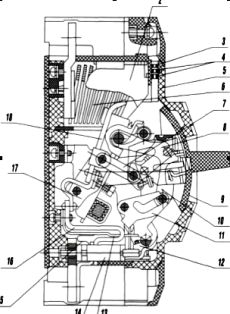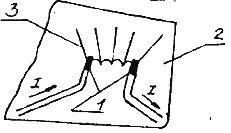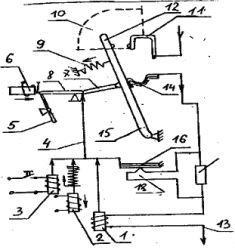Breaker device
A circuit breaker (machine) is used for infrequent switching on and off of electrical circuits and for protecting electrical installations from overloads and short circuits, as well as from unacceptable voltage drops.
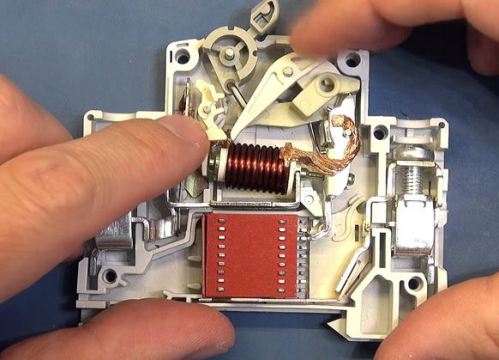
Compared to fuses the circuit breaker provides more effective protection, especially in three-phase circuits, because in the event of, for example, a short circuit, all phases of the network are switched off. Fuses in this case, as a rule, cut off one or two phases, which creates an open phase mode, which is also an emergency.

Circuit breaker (Fig. 1) consists of the following elements: housing, arc channels, control mechanism, switching device, releases.
Rice. 1. Circuit breaker, series BA 04-36 (circuit breaker device): 1 base, 2 arc extinguishing chambers, 3, 4 spark extinguishing plates, 5 covers, 6 plates. 7-link, 8-link, 9-handle, 10-support lever, 11-lock, 12-switch, 13-thermo-bimetal plate, 14-electromagnetic release, flexible wire, 16-conductor, 17-contact stand, 18 - removable contacts
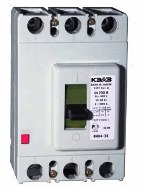 To turn on the circuit breaker in the off position (position «Automatic shutdown»), the mechanism must be raised by moving the handle 9 of the circuit breaker in the direction of the «O» sign until it stops. In this case, the lever 10 engages with the lock 11, and the lock with the disconnecting bus 12. The subsequent inclusion is carried out by moving the handle 9 in the direction of the sign «1» until it stops. The failure of the contacts and the compression of the contacts during switching on is ensured by the displacement of the movable contacts 18 relative to the contact holder 17.
To turn on the circuit breaker in the off position (position «Automatic shutdown»), the mechanism must be raised by moving the handle 9 of the circuit breaker in the direction of the «O» sign until it stops. In this case, the lever 10 engages with the lock 11, and the lock with the disconnecting bus 12. The subsequent inclusion is carried out by moving the handle 9 in the direction of the sign «1» until it stops. The failure of the contacts and the compression of the contacts during switching on is ensured by the displacement of the movable contacts 18 relative to the contact holder 17.
Automatic shutdown of the machine occurs when the opening bar 12 rotates with each release, regardless of the position of the handle of the switch 9. In this case, the handle occupies an intermediate position between the signs «O» and «1», which indicates that the circuit breaker opens automatically . Arc chambers 2 are installed in each pole of the breaker and are deion grids consisting of several steel plates 6.
Spark arrestors containing spark arrestor plates 3 and 4 are secured in the switch cover 5 in front of the gas outlets in each pole of the switch. If in the protected circuit, at least one pole, the current reaches a value equal to or exceeding the current setting value, the corresponding release is turned off and the switch disconnects the protected circuit, regardless of whether the handle is held in the closed position or not. An electromagnetic overcurrent release 14 is installed in each pole of the breaker. The release performs the function of instant protection against short circuit.
Arc extinguishing devices required in electrical appliancesswitching of large currents as it occurs at the current break electric arc causes burning of contacts. Circuit breakers use deion arc extinguishing chambers. With arc extinguishing (Fig. 2.) above contacts 1 placed inside the arc chute 2, there is a grid of steel plates 3. When the contacts open, the arc formed between them is blown by an air stream, enters the area of the metal grill and quickly extinguishes.
Rice. 2. Location of the arc extinguishing chamber of the breaker: 1- contacts, 2- the body of the arc extinguishing chamber, 3- plates.
The schematic and main elements of the circuit breaker are shown in Figure 3.
Rice. 3. Breaker device: 1- maximum release, minimum release, shunt release, 4- mechanical connection with the release, 5 manual closing handle, 6- electromagnetic drive, 7,8- free release levers, 9- opening spring, 10- arc chute, 11- fixed contact, 12- movable contact, 13- protected circuit, 14- flexible connection, 15- pin lever, 16- thermal release, 17- additional resistance, 18- heater.

Control mechanism designed to provide manual switching on and off of the device using buttons or a handle.

Breaker device
A circuit breaker switching device consists of movable and fixed contacts (power and auxiliary). A pair of contacts (movable and fixed) form a circuit breaker pole, the number of poles can be from 1 to 4. Each pole is terminated with a separate rainbow chute.
The mechanism that activates the circuit breaker in emergency modes is called a release... There are the following types of releases:
— electromagnetic maximum current (to protect electrical installations from short-circuit currents),
— thermal (for overload protection),
— combined, with electromagnetic and thermal elements,
— lower voltage (to protect against unacceptable voltage drop),
— independent (for remote circuit breaker control),
— special (for implementing complex protection algorithms).
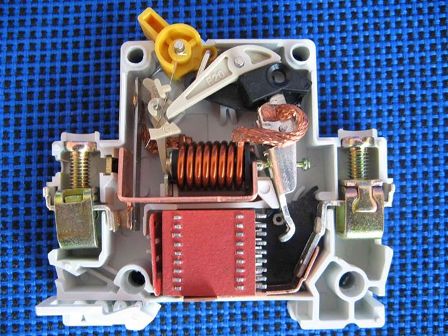
Breaker device
An electromagnetic release circuit breaker is a small coil with a coil of insulated copper wire and a core. The coil is connected to the circuit in series with the contacts, that is, the load current passes through it.
In the event of a short circuit, the current in the circuit increases sharply, as a result of which the magnetic field created by the coil causes the core to move (pull into or out of the coil). When moving, the core acts on the tripping mechanism, causing the power contacts of the circuit breaker to open. There are circuit breakers with solid state releases that react to overcurrent.
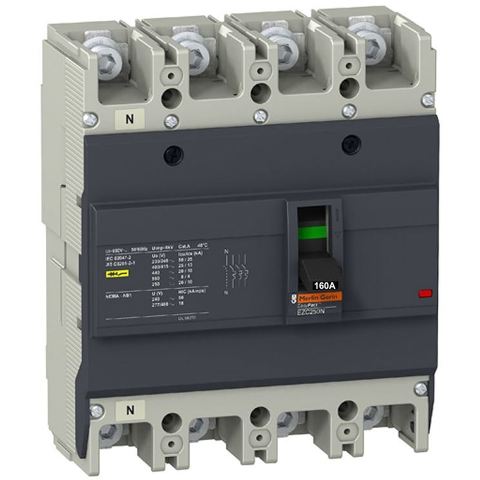
Thermal release automatic knife is bimetallic platemade of two metals with different coefficients of linear expansion firmly bonded together. Plate is not an alloy of metals; they are usually pressed together. The bimetallic plate is connected in an electric circuit in series with the load and is heated by an electric current.
As a result of heating, the plate bends towards the metal with a lower coefficient of linear expansion. In the event of an overload, that is, with a small (several times) increase in the current in the circuit compared to the nominal, the bimetallic plate, bending, causes the circuit breaker to turn off.
The tripping time of the thermal release of the circuit breaker depends not only on the magnitude of the current, but also on the ambient temperature, therefore, in a number of designs, temperature compensation is provided, which ensures the correction of the tripping time in accordance with the air temperature.
Low-voltage shunt by design they are similar to electromagnetic and differ from it in operating conditions. In particular, the shunt release ensures the shutdown of the machine when voltage is applied to the release, regardless of the presence of emergency modes.
These releases are optional and may not be included in the breaker design. There are also non-release switches, in which case they are called switch-disconnectors.
Circuit breakers are now widely used AP50B, AE10, AE20, AE20M, VA04-36, VA-47, VA-51, VA-201, VA88, etc. Automatic switches AP50B are produced for rated currents up to 63A, AE20, AE20M - up to 160A, VA-47 and VA -201 — up to 100A, VA04-36 — up to 400 A, VA88 — up to 1600A.

